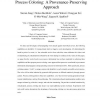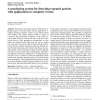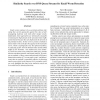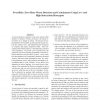191 search results - page 12 / 39 » On Detecting Camouflaging Worm |
TPDS
2008
13 years 9 months ago
2008
To detect and investigate self-propagating worm attacks against networked servers, the following capabilities are desirable: (1) raising timely alerts to trigger a worm investigat...
IJISEC
2006
13 years 9 months ago
2006
Abstract We present a monitoring system which detects repeated packets in network traffic, and has applications including detecting computer worms. It uses Bloom filters with count...
AINA
2009
IEEE
14 years 4 months ago
2009
IEEE
Email worms continue to be a persistent problem, indicating that current approaches against this class of selfpropagating malicious code yield rather meagre results. Additionally,...
CN
2007
13 years 9 months ago
2007
As next-generation computer worms may spread within minutes to millions of hosts, protection via human intervention is no longer an option. We discuss the implementation of SweetB...
WORM
2003
13 years 11 months ago
2003
This paper presents DOME, a host-based technique for detecting several general classes of malicious code in software executables. DOME uses static analysis to identify the locatio...




